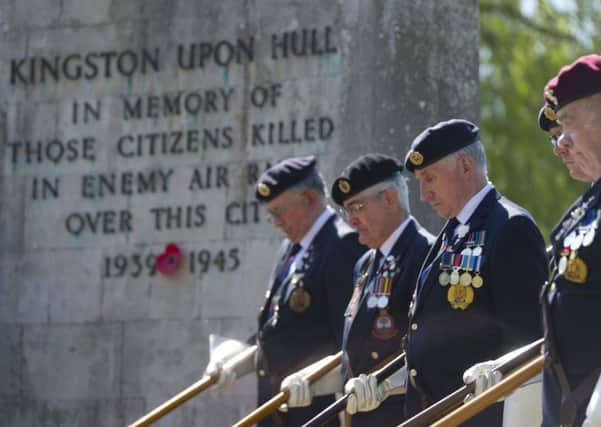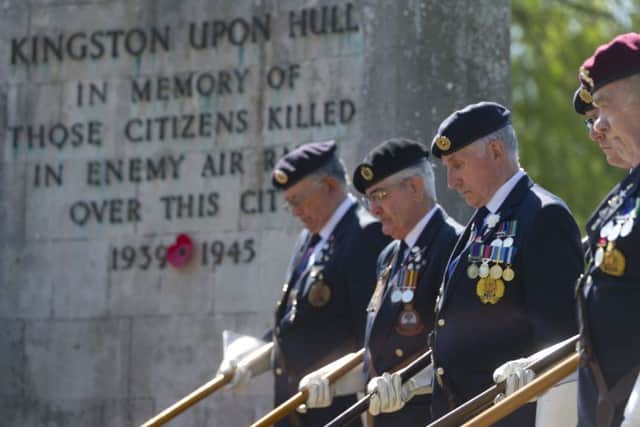In pictures: 75th anniversary memorial service remembers Hull Blitz victims


Nazi bombs left hundreds dead and the city’s architecture crumbling in enemy air raids that contributed to it being the most devastated place in the UK during the Second World War.
Overnight between May 7-8, 1941, more than 70 German aircraft dropped 110 tonnes of high explosives, as well as 9,648 incendiary bombs. Some 420 people were killed and another 350 were seriously injured.


Advertisement
Hide AdAdvertisement
Hide AdOn the anniversary of the air raids today, city dignitaries marked the occasion. A memorial service held at the Memorial Cenotaph in Northern Cemetery at 2pm opened with a prayer as members of the community gathered solemnly to remember the local people who lost their lives in what is known as the ‘Hull Blitz’.
The Lord Mayor of Hull, Councillor Anita Harrison, led the civic dignitaries at a 30-minute service hosted by Reverend Stephen Whaley.
The Lord Mayor and representatives of Humberside Police, Humberside Fire and Rescue Service and St John Ambulance all laid wreaths, as retired members of the armed forces looked on.
The Lord Mayor told The Yorkshire Post: “The Blitz of 75 years ago changed our city forever. And I think it has to be recognised what Hull went through. It was bombed more than London on those nights and it is something that has to go down in the record books so people can remember the innocent people who died.”


Advertisement
Hide AdAdvertisement
Hide AdAt Hull History Centre, a ‘Wardens, Welfare & Victory’ exhibition celebrates the spirit of the Blitz.
The determination of the city’s people to recover from those dark days is a source of pride, Lord Mayor said.
“Hull has a spirit of its own. In 1941 it was brought to its knees but we have fought back and got on with it. It was also a sense of humour that got people through.”
The bombs were dropped as German planes flew home over the East Coast because they had been unable to reach their primary target, which in this case was Liverpool.


Advertisement
Hide AdAdvertisement
Hide AdBut worse was to come in the nights that followed. Between midnight on May 8 and 3.40am on May 9, another 157 tonnes of high explosives and 19,467 incendiaries were dropped by 120 bombers. The intended target had been Sheffield.
As well as being bombed because other targets could not be found or were too well protected, Hull’s docks, industry and railways were key targets.
By the time the war was over, Hull had endured more than 1,000 hours under air raid alert and only 6,000 out of 91,000 homes were undamaged.
The city’s civilian war dead is officially recorded as 1,243, though in recent years that figure was said to stand at 1,458, according to amateur historian Malcolm Mann, whose research took into account those who died in accidents during the air raids or committed suicide when their nerves could not take the bombing any longer.


Advertisement
Hide AdAdvertisement
Hide AdMore than half the city’s population was made homeless and Hull was found to have been the most devastated place in the UK, taking 34 per cent more damage than London.
A memorial bearing the names of those who lost their lives during the Blitz is due to be installed opposite the City Hall, thanks to a £120,000 fundraising campaign by the independently-run Hull People’s Memorial Fund.
ANONYMOUS AFTERMATH
Media reports at the time of the Hull Blitz in 1941 did not mention the city by name.
This was a deliberate tactic to divert attention and play down its significance. Instead it was referred obliquely as a “north-east town”.
Advertisement
Hide AdAdvertisement
Hide AdHull had been the subject of a ‘D Notice’ - a voluntary request to news media not to disclose certain information for reasons of national security, as the Cabinet was concerned the city’s suffering would lower national morale.


On May 9, The Yorkshire Post carried a front page report with the headline “North-East Heroism”. Written by the newspaper’s “special correspondent” it chronicled the scale of the devastation, but also captured the stoicism of local communities.